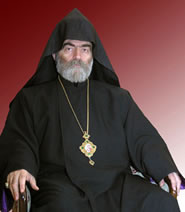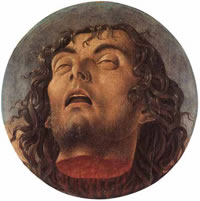Holy See of Gandzasar of the Armenian Apostolic Church

His Beatitude Archbishop Pargev, head of the Artsakh Diocese of the Armenian Apostolic Church, with seat at the Gandzasar Monastery.
The Gandzasar Monastery is located in the Mardakert District of the Nagorno Karabakh Republic, and is about two hours drive from the republic’s capital city of Stepanakert. It stands atop of Mount Gandzasar (hence the name), a large green hill that rises above the historical town of Vank.
The name "Gandzasar" (Armenian:
Գանձասար) is translated from Armenian as "Treasure
Mountain." "Gandz" (Armenian:
գանձ) means "treasure" and "sar"
(Armenian:
սար) means "mountain," which point to ancient copper and silver mines found in the vicinity. But there can be little doubt that the real treasure is the architectural and historical significance of the monastery that adorns the mountain.
Gandzasar is a walled abbey with both ecclesiastical and non-ecclesiastical buildings, the centerpiece of which is the Cathedral of St. Hovhannes Mkrtich (
St. John the Baptist;
Armenian:
Սբ.
Հովհաննես
Մկրտիչ), a large church with a cupola in the
inscribed cross plan.
The foundations of the Cathedral were laid in 1216 by Prince Hasan Jalal Vahtangian, a powerful Armenian feudal lord who referred to himself as Grand Prince, Prince of Princes and King (tagavor; Armenian:
թագավոր).
Prince Hasan Jalal relates to one of the most ancient aristocratic families in world history—the Arranshahiks—who ruled eastern Armenian lands since early medieval times, if not well before.
Hasan Jalal’s successors, who assumed the surname Hasan-Jalalian in memory of their celebrated grandparent, branched out into two lines. The clerical line hereditarily controlled top positions of the Holy See of Gandzasar, while the original, princely one, continued administering the Province of Khachen as princes and meliks (dukes).
First records about the Gandzasar Monastery go back to the tenth century. In his encyclical titled “On the Rebellion of the House of Aghvank,” Anania Mokatsi (reigned from 946-968), Katholicos of All Armenians, writes that in order to resolve disputes which arose in 949 due to differing interpretations of the Holy Trinity, he “ordered to hold an assembly in the province of Khachen, with the participation of priests and nobility.” [1] Katholicos Anania mentions among the invited “Father Sargis, a monk from Gandzasar.” The same Father Sargis, apparently an important churchman of his time, was noted by the Armenian historian Stepanos Orbelian in his “History of the Land of Sisakan.” [2]
Gandzasar shared the turbulent history of the Armenian people. In a colophon, from 1417, the superior of the monastery deplores the situation whereby the princes of Khachen are “in the hands of lawless people” and “the House of Armenia is thus weakened.”
The monastery was sacked several times, most notably—by Mongol hordes, in the beginning of the thirteenth century. In the late eighteenth century, Gandzasar was looted by the gangs of the Turkic chieftain Ibrahim-Khalil Javanshir—a tribal lord from the family of the self-proclaimed “Khans of Karabakh.” By usurping Artsakh’s Castle of Shushi for over 50 years (until driven out and assassinated by Russians and Armenians, in 1805), Ibrahim—and his father Panah-Ali before him—had been terrorizing Gandzasar’s clergy. In 1786, this policy culminated in capturing, torturing and killing Gandzasar’s Katholikos Hovhannes Gandzasaretsi and his brothers, by Ibrahim’s henchmen. Most recently Gandzasar was attacked in 1992, in the course of Azerbaijan ’s anti-Armenian aggression and Nagorno Karabakh’s heroic self-defense. But despite the challenges before them, Armenians—whether throughout the Middle Ages or in the twentieth century—always organized extraordinary measures to defend Gandzasar and shield it from damage.
Autonomous Divisions of the Armenian Apostolic Church
The Armenian Apostolic Church has been a key national institution of Armenia. It provided spiritual guidance, supported national institutions, created the Armenian alphabet, and unified the nation in times when its statehood was weakened by foreign invasions.
In medieval times, chiefly because of geographical barriers and feudal fault lines that carved up historical Armenia into separate Armenian kingdoms, key divisions of the Church (katholicosates, patriarchates and archbishoprics) often had to lead semi-autonomous existence. Nonetheless, all of them recognized the authority of one central katholicosate (top patriarchate) of the Armenian Apostolic Church: the Mother See (Armenian: Մայր Աթոռ).
The head of the Mother See is the supreme patriarch of the Church, called the Katholicos of All Armenians (Armenian:
Կաթողիկոս Ամենայն Հայոց).
His traditional and present residence is in Saint Echmiadzin, the birthplace of Armenian Christianity, which is oftentimes referred to as “Armenian Vatican.” A large religious complex with churches and seminaries, Saint Echmiadzin occupies a central quarter of the city of Vagharshapat, and is located 15 miles east of Yerevan, the capital of the modern Republic of Armenia.
From the 14th century to 1836, the Gandzasar Monastery hosted the Katholicosate of Aghvank (Armenian:
Աղվանից Կաթողիկոսություն), the easternmost subdivision of the Armenian
Apostolic Church. When the Katholicosate of Aghvank moved to Gandzasar from the Amaras Monastery, it became known as the Holy See of Gandzasar. As such, Gandzasar was in charge of parishes in two historical Armenian provinces, Artsakh and Utik, and all territories that lied between the eastern borderlands of Armenia and the Caspian Sea.
The importance of the Holy See of Gandzasar in Armenian political and religious life was very high. Gandzasar’s power peaked two times. Near the end of the fourteenth century, when the Armenian Kingdom of Cilicia, an independent Armenian state on the Mediterranean Sea, was conquered by the Mamluk Sultanate of Egypt , the idea was born—though not realized—of transferring to Gandzasar the Mother See, then in Cilicia. [3] Next time, in the beginning of the eighteenth century, Gandzasar’s power expanded under its strong leader, Katholikos Yesai Hasan-Jalalian. Despite the muted displeasure of the Mother See of Saint Echmiadzin, for several decades Gandzasar was recognized by the Russian imperial court and European monarchs as the sole representative of all Armenian Christians. [4]
Gandzasar was not the only semi-autonomous subdivision of the Armenian Apostolic Church. Below is an incomplete list of some other units of the Church, which had analogously self-governing status in various periods of the Church’s history:
- Holy See of Cilicia. Also known as the Katholicosate of the Great House of Cilicia, the Holy See of Cilicia was based in various parts of this Mediterranean region. Its most notable headquarter was the in city of Sis, capital of the independent Armenian Kingdom of Cilicia (1078-1375). For several centuries, the kingdom housed the Mother See, which moved its headquarters from Saint Echmiadzin in 1292, seeking the security and protection of Cilicia’s Armenian rulers. When the Mother See moved back to Saint Echmiadzin, in 1441, Cilicia organized its own ecclesiastical domain. The Holy See of Cilicia exists to this day, as an integral part of the Armenian Apostolic Church. In 1930, after the establishment of the Turkish Republic, it moved its headquarters from Sis to Antelias, Lebanon.
- Holy See of Akhtamar. The island of Akhtamar on the Lake Van, with its large and unique cathedral of St. Cross, served as a spiritual home of Armenia ’s southern Kingdom of Vaspurakan and adjacent territories, from 1113 to 1895. Khachatur III, who died in 1895, was the last Katholikos of Akhtamar. The last vestiges of the Akhtamar Katholicosate were destroyed by Ottoman Turks during the Armenian Genocide (1915-1922).
- Metropolitanate of Syunik. Also known as the Holy See of Syunik, this division of the Armenian Apostolic Church was in charge of parishes in Armenia ’s eastern province of Syunik, beginning from the 10th century. The Metropolitanate was fully instituted in 1286, and its status confirmed by the Mongol Khan. It was housed in the Tatev Monastery, located 100 miles south-west of Gandzasar, on the territory of modern Province (marz) of Syunik of the Republic of Armenia.
- Patriarchate of Constantinople. In 1461, Sultan Muhammad II laid the ground for the establishment of the Armenian Patriarchate of Constantinople by elevating the status of Bishop Hovakim of Bursa. Largely because the Mother See of Saint Echmiadzin was based on the territory of
Eastern Armenia—then part of rival Persia—the Sultan sought to control Armenians living within the boundaries of his growing empire through a different patriarchal authority. The katholicosates of Akhtamar and Cilicia were later subordinated to the Patriarchate of Constantinople in most administrative matters. The Patriarchate of Constantinople exists to this day, as an integral part of the Armenian Apostolic Church.
- Patriarchate of Jerusalem. In 1307, King Oshin I, of the Armenian Kingdom of Cilicia, and the Cilicia-based Katholicos Constantine III, forced the Armenian
Church to adopt the dogmatic and ritual changes of the Council of Sis, which were inspired by Catholicism. Bishop Sargis of Jerusalem, wishing to preserve the purity of the doctrine of the Armenian Apostolic Church, obtained an official document from the Sultan of Egypt, permitting him to take his See from the control of the Katholicos of All Armenians to function independently as of 1311. Patriarchate of Jerusalem exists to this day, as an integral part of the Armenian Apostolic Church. It is domiciled in the Armenian Quarter of Jerusalem’s Old Town.
Claim to the Possession of Relics of St. John the Baptist

Head of St. John the Baptist; work of Giovanni Bellini (1430-1516). The Gandzasar’s Monastery’s Cathedral of St. John the Baptist was erected in 1238 by Grand Prince Hasan Jalal Vahtangian, Lord of Khachen, above what he believed was a key Christian relic: St. John’s head. The relic was brought to Gandzasar in 1211.
Armenians believe that Gandzasar’s Cathedral contains or contained in the past a key Christian relic: head of St. John the Baptist.
A discussion about how the head of St. John the Baptist ended up in Artsakh and in Gandzasar can be found in the “History of the Land of Aghvank,” a collection of texts attributed to the medieval Armenian historian Movses Kaghankatvatsi. Written largely in the seventh century, and expanded in the following centuries, this historical compilation deals mostly with Armenia’s provinces of Artsakh and Utik after the partition of the Kingdom of Armenia between Byzantium and Persia in 387 AD, and the emergence of the Armenian-ruled Kingdom of Aghvank on the territory of the present-day Nagorno Karabakh Republic and adjacent lands.
The “History” includes a special appendix called “On the Sacred Head of John the Baptist, and about how it was Brought to the Province of Artsakh and Deposited in the Holy See of Gandzasar.” [5] This text suggests that after many centuries of being sent from one place to another, the severed head of St. John was taken, by a certain prince, to Constantinople, where “… Catholics tried to steal it.” To escape the
wrath of the Catholics, the prince traveled to Iberia (modern Georgia ), where the head “became the possession of Hasan Jalal’s brother, then ruler of Artsakh.”
According to the text, in 1211 Hasan Jalal visits his brother and asks to hand over the holy relic to him. After a refusal, Hasan Jalal seizes the head by force and takes it back to “his dynasty’s sepulcher, in Artsakh.” There, above the relic, he erects the Cathedral and names it after the saint. The appendix also mentioned that in addition to St. John’s head Hasan Jalal’s crypt also contained the jaw of St. Gregory the Enlightener—Armenia’s foremost saint who baptized Armenia into the world’s first Christian kingdom; the right arm of St. Zachary—father of St. John the Baptist; relics of St. Pantaleon (St. Panteleimon)—a Christian healer revered in eastern lands of Armenia; as well as relics of St. Joseph of Arimathea, who, according to the Gospels, was the man who donated his own prepared tomb for the burial of Jesus after the crucifixion.
That the legend linking St. John to Gandzasar had a strong spiritual and political significance was indirectly confirmed in the 17th century by Petros Khandzketsi, Katholicos of the Holy See of Gandzasar (reigned from 1653-1675). In his letter written in 1672 and addressed to the Russian monarch Aleksei I Romanov (father of the Tsar Peter I the Great), the Katholicos tries to highlight the importance of Artsakh and other east Armenian lands under his spiritual guardianship by using the claim that Gandzasar had been a repository of many treasured Christian relics. Katholicos Petros IV writes:
“To the Tsar crowned by Christ … from the slave of God, Peter (Petros), the Armenian Katholikos, with prayers of Gregory the Great of Greater Armenia (Gregory the Enlightener). I am the Patriarch of the Holy See of Gandzasar, where the holy relics of St. John the Baptist, Gregory the Great, Joseph of Arimathea, and others are located and from where we call upon the apostles of Jesus Christ and the Holy Ghost to guard your throne, the city of Moscow, and your entire kingdom …” (Source: George A. Bournoutian. Armenians and Russia, 1626-1796: A Documentary Record, Costa Mesa, CA: Mazda Publishers, 2001, p. 21; explanatory parentheses by ARACS)
Gandzasar as an Armenian Political Center
The importance of the Holy See of Gandzasar and the status of descendents of Hasan Jalal Vahtangian—the Hasan-Jalalians—as both princes and bishops made the monastery not only a religious but also a political center of Artsakh and the whole of Armenia.
It was under the influence of the Holy See of Gandzasar that the leaders of Armenian nobility wrote their famous appeals to the Russian Tsar Peter I the Great, in 1699 and 1703, asking him for assistance in their struggle against Muslim domination. [6] Katholikos Yesai Hasan-Jalalian (reigned from 1702-1728) played a key role in the consequent Armenian national liberation movement, assuming not only religious and administrative but also military leadership of eastern provinces of Armenia.
In 1711, Katholikos Yesai accompanied the Armenian patriot Israel Ori (a prince from the Proshian family, related to Hasan-Jalalians through common
Arranshahik ancestors), by traveling to Russia to help build support for an army that could fight alongside Tsar Peter the Great’s Russian troops. Ori, however, died during the journey, and Katholikos Yesai soon took over the diplomatic mission. He continued negotiations with Tsar Peter I, and in a letter sent to him in 1718,
promised to raise a 10-12,000-strong Armenian army and secure support from neighboring Georgia. [7]
In 1714, Katholikos Yesai invited Artsakh’s meliks (dukes) and clergy to his residence near the Cathedral of St. John the Baptist in order to discuss and sign a 23-point Covenant of Gandzasar, a document that defined relations and status of civilian, military and clerical powers in the province of Artsakh. [8]
There is specific evidence about the power of the Holy See of Gandzasar in the 1700s and its centrality in Armenian politics. It comes from Archimandrite Minas Tigranian, an abbot from Gandzasar’s neighboring Metzarank Monastery and one of key figures of Armenian national liberation movement. Minas Tigranian was later ordained archbishop by Katholikos Yesai and appointed as Armenia’s envoy to Russia. After completing his secret mission to Persian-controlled Armenia he stated in a report dated March 14, 1717:
“The “[Gandzasar] patriarch has under his [religious] authority 900 villages, and these are big villages, with 100, 200, 300, 400 and more households. It is a five-day journey on packed horses from Gandzasar to the monastery of Echmiadzin, where the other patriarch resides (i.e. Katholicos of All Armenians). The latter has even more villages under his authority than the Patriarch Yesai has, but he [i.e. Minas] does not know their exact number. Altogether, under the authority of these two patriarchs there are some 200,000 [households] of Armenians, the merchants and the peasantry." (Source: Bournoutian, George A. Armenians and Russia, 1626-1796: A Documentary Record. Costa Mesa, CA: Mazda Publishers, 2001, p. 86; explanatory parentheses by ARACS).
The army organized and inspired by Katholikos Yesai and led by Armenian centurions from Artsakh and Syunik never received the promised Russian support, largely because of Tsar Peter’s unexpected death in 1725. However, virtually without any external assistance, that army successfully fought against the invading Ottoman Turks during Eastern Armenia’s self-defense war of the 1720s-1730s.
Katholikos Yesai is buried in the vestibule of Gandzasar’s Cathedral of St. John, near the tomb of Hasan Jalal Vahtangian, his grand ancestor. The inscription on his tombstone reads: “This is the tomb of Yesai, the Armenian Katholikos of Aghvank, who is from the dynasty of [Hasan] Jalal Dola.”
Gandzasar as a Center of Culture and Scholarship
In addition to being an architectural masterwork, a major Christian shrine and a political hub, Gandzasar is also known for its role as a center of culture and scholarship.
The ancient fort of Aghven, that was located near Gandzasar, is considered as the birthplace of the first Armenian constitutional edict: the "Canons of Aghven," written in the 5th century AD at the request of King Vachagan II the Pious. The full text of the constitution, which consists of 21 tenets, is part of Movses Kaghankatvatsi's medieval text "History of the Land of Aghvank." [9] In 728 AD, the Armenian Katholikos Hovhannes III Odznetsi included the “Canons of Aghven” into his treatise called “Armenian Book of Canons” (Armenian: “Կանոնագիրք Հայոց”). A copy of the “Canons” is proudly displayed at the Matenadaran—Armenia’s Institute of Ancient Manuscripts.
Gandzasar also is home to Armenia's first completed Haysmavurk (Synaxarion in Greek, Armenian: Հայսմավուրկ; also known as the “Book of Saints”), a calendared collection of short lives of
saints and accounts of important religious events. The idea to have a new, better organized Haysmavurk came from Gandzasar’s patron Grand Prince Hasan Jalal Vahtangian himself, who then placed his request with Ter-Israel (Father Israel)—a disciple of an important Armenian medieval philosopher and Artsakh’s native known as Vanakan Vardapet (1181-1251). [10] The Haysmavurk was further developed by Kirakos Gandzaketsi (1200-1271), the author of the “History of Armenia.” Gandzasar’s edition of Haysmavurk became known in annals of world religious literature as “Synaxarion of Ter-Israel;” it was mass-published in Constantinople in 1834.
It also was in Gandzasar, where the 13th century scholar Mkhitar Gosh worked on his “Code of Laws,” Armenia’s first comprehensive compilation of civil legal regulations. From that time and up to the 19th century, the Code was used as the main legal reference both in Armenia and in its medieval Diaspora, from Poland to Hungary to Crimea and Persia. [11]
Gandzasar had a large scriptorium where ancient manuscripts were reproduced and illuminated. In the thirteenth century, the scriptorium produced the famous “Red Gospel of Gandzasar,” a thick volume with 313 parchment pages, currently on display at the library of the University of Chicago, USA.















